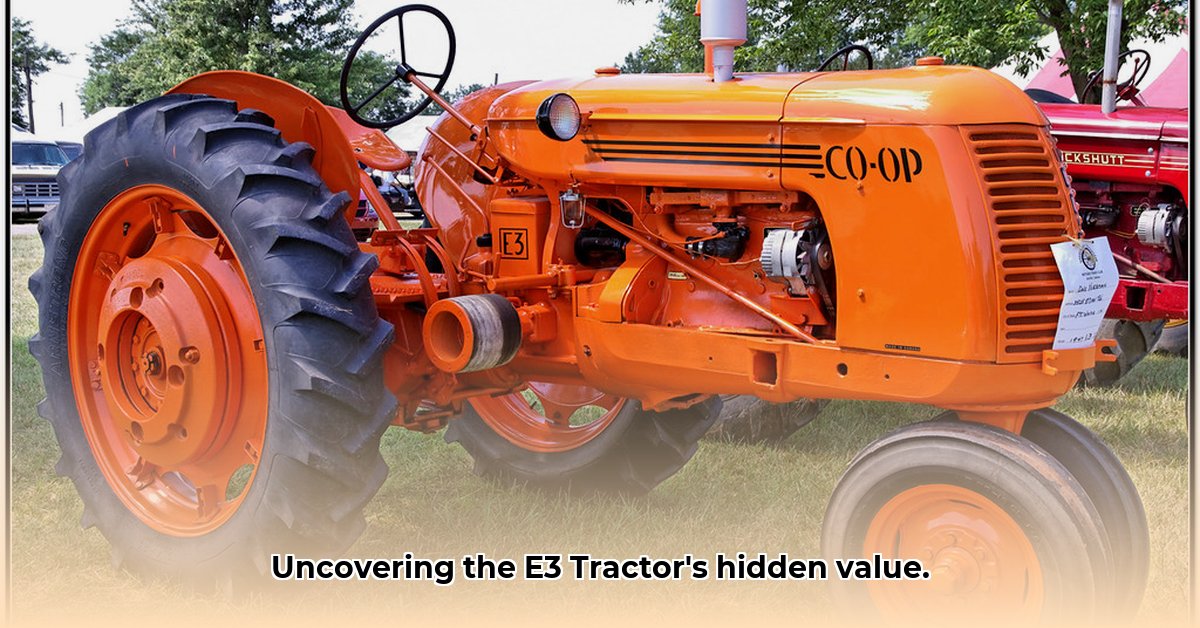
A Piece of Farming History
The Co-op E3 tractor, essentially a rebranded Cockshutt 30, represents a significant chapter in North American agricultural history. With approximately 37,000 units produced, these tractors were a ubiquitous sight in fields across the continent. But what drives their current appeal among collectors? This comprehensive guide delves into the Co-op E3's history, technical specifications, market performance, and provides actionable advice for collectors and enthusiasts. We'll explore everything from decoding the variations in reported horsepower to identifying an authentic E3 and assessing its condition for restoration. For those considering using one for their own farm work, you might want to check out tractor rental costs.
Decoding the Horsepower Mystery
The Co-op E3's horsepower rating remains a point of discussion. Factory specifications ranged from 21 to 28 horsepower, depending on the measurement point (drawbar or PTO). However, independent testing yielded figures between 27 and 31.88 horsepower, creating a fascinating discrepancy. Why the variation? Factory figures often represent ideal, laboratory conditions, while real-world testing accounts for wear and tear, and differing methodologies. Auction listings add another layer of complexity, sometimes reporting horsepower as high as 37! The truth likely lies somewhere within the broader range observed in testing.
Here's a summary of the varying horsepower figures:
| Reported Horsepower Source | Estimated Actual Horsepower Range | Potential Reasons for Discrepancy |
|---|---|---|
| Manufacturer's Specs | 27-32 hp | Idealized testing environment; minimal wear and tear on the engine. |
| Auction Listings | 25-35 hp | Wide range due to tractor condition, varying testing methods, and subjective assessment. |
| Independent Testing | 27.25 - 31.88 hp | Rigorous, controlled testing, more likely to reflect typical performance after break-in period. |
This variability highlights the challenge of using horsepower as the sole determinant of value. A nuanced understanding of the testing context shapes the accurate interpretation of these numbers.
Market Analysis: Trends and Influencing Factors
The Co-op E3 market is dynamic, reflecting the interplay of several key factors affecting price:
Condition: A meticulously preserved, original tractor, often fetches significantly higher prices than a neglected unit requiring extensive repairs. This parallels the classic car market, where pristine examples are highly prized.
Year of Manufacture: Earlier models, due to their relative rarity, often command a premium among collectors. This principle applies to many collectible items – rarity often equates to a higher value.
Location: Geographical location impacts market demand. A region with a high concentration of vintage tractor enthusiasts might lead to higher prices compared to an area with less demand. Supply and demand dynamics determine value in any collectible market.
Reliable pricing data remains scarce due to the lack of a centralized, comprehensive database on Co-op E3 sales. More data is needed to reliably illustrate price trends over time. This underscores the need for sustained research in this area. How can this data gap be bridged to more accurately reflect the trends in the Co-op E3 market?
Collector's Guide: Identification, Assessment, and Restoration
Aspiring Co-op E3 owners should navigate the vintage tractor market with a structured approach:
1. Authenticity Verification: Start by verifying the tractor's serial number using resources like online forums and vintage tractor clubs. Thorough cross-referencing ensures authenticity.
2. Condition Assessment: A detailed inspection is paramount. Assess rust, wear, mechanical functionality (engine, transmission, hydraulics), and the overall structural integrity. Consulting a vintage tractor mechanic can provide invaluable expertise.
3. Parts Sourcing: Finding replacement parts for a vintage tractor can be challenging. Online forums, specialized parts suppliers, and collector communities are excellent platforms to source necessary components and parts.
4. Restoration Planning (if necessary): A comprehensive restoration is a substantial undertaking, demanding meticulous planning and record-keeping. Thorough documentation enhances the tractor's value and preserves its history for future generations. This detailed recordkeeping can significantly enhance the value of your restoration.
Conclusion: A Rewarding Investment?
The Co-op E3 represents more than just a vintage tractor; it's a tangible piece of agricultural heritage. Despite the challenges in precisely defining its current market value, its historical importance and the active enthusiast community indicate a potentially strong investment for collectors. Continued research, broader data collection, and improved price tracking mechanisms will shed more light on the Co-op E3 market in the years to come. The journey of acquiring, maintaining, and potentially restoring a Co-op E3 combines meticulous research, hands-on restoration, and the personal satisfaction of preserving a significant piece of agricultural history.